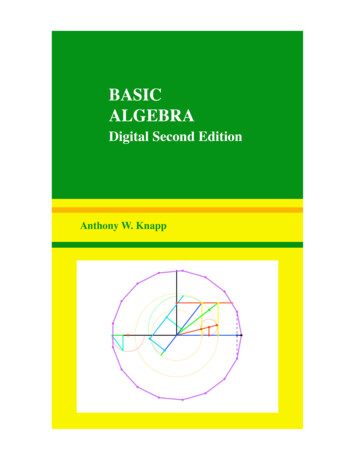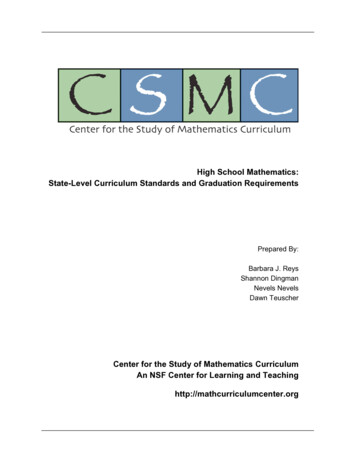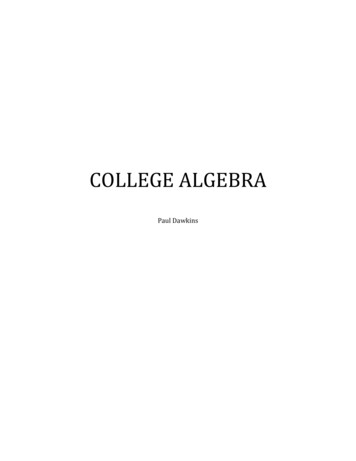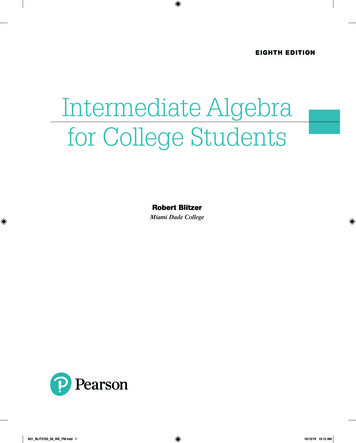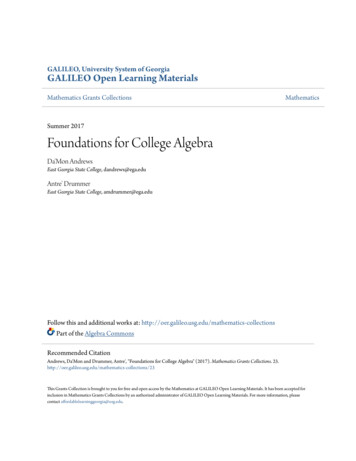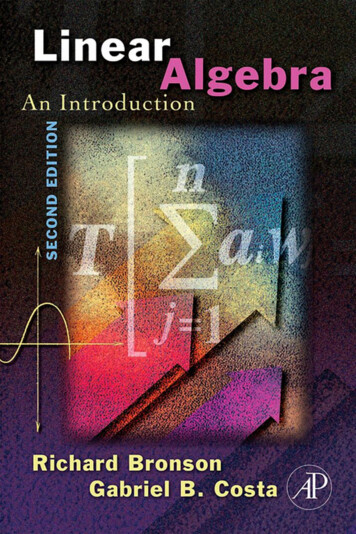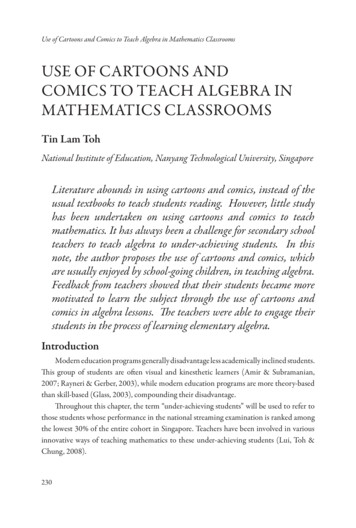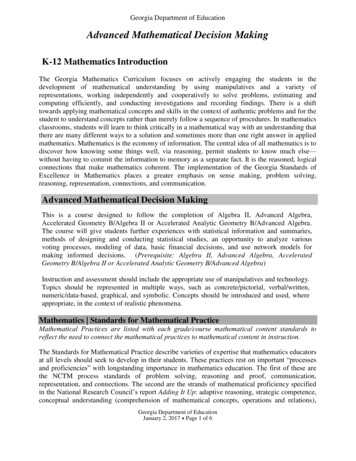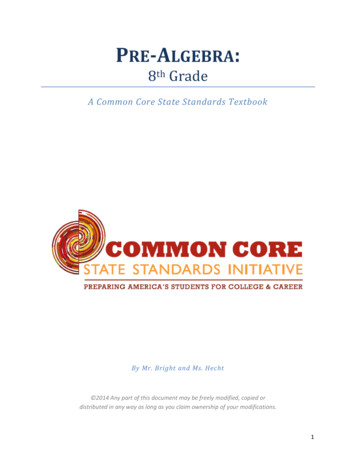
Transcription
PRE-ALGEBRA:8th GradeA Common Core State Standards TextbookBy Mr. Bright and Ms. Hecht 2014 Any part of this document may be freely modified, copied ordistributed in any way as long as you claim ownership of your modifications.1
2
Table of ContentsUnit 1: Exponents CC STANDARDS COVERED: 8.EE.1, 8.EE.3, 8.EE.41.1 Operations with Exponents1.2 Negative Exponents1.3 Negative Exponent Operations1.4 Scientific Notation and Appropriate Units1.5 Scientific Notation OperationsUnit 2: Similar and Congruent CC STANDARDS COVERED: 8.G.1, 8.G.2, 8.G.3,8.G.4, 8.G.52.1 Constructing Dilations2.2 Constructing Reflections2.3 Constructing Rotations2.4 Constructing Translations2.5 Identifying Series and DeterminingCongruence or Similarity2.6 The Sum of Angles in a Triangle2.7 Similar Triangles2.8 Parallel Lines Cut by a TransversalUnit 3: Functions CC STANDARDS COVERED: 8.F.1, 8.F.3, 8.F.4,8.F.5, 8.EE.6Unit 4: Linear Functions CC STANDARDS COVERED: 8.F.2, 8.F.4, 8.EE.5,8.EE.64.1 Equations of Linear Functions4.2 Graphs of Linear Functions4.3 Tables of Linear FunctionsUnit 5: Solving Equations CC STANDARDS COVERED: 8.NS.1, 8.EE.2, 8.EE.75.1 Solving by Combining Like Terms5.2 Solving with the Distributive Property5.3 Solving with Variables on Both Sides5.4 Infinite/No Solution and Creating Equations5.5 Solving Exponent EquationsUnit 6: Systems of Equations CC STANDARDS COVERED: 8.EE.86.1 Graphing with Slope-Intercept Form6.2 Solving Systems via Graphing6.3 Solving Systems via Substitution6.4 Solving Systems via Elimination6.5 Solving Systems via Inspection3.1 Intro to Functions3.2 Graphing Functions3.3 Linear and Non-Linear Functions3.4 Exploring Linear Functions3.5 Increasing, Decreasing, Max and Min3.6 Contextualizing Function Qualities3.7 Sketching a Piecewise Function3
Unit 7: Irrational Numbers CC STANDARDS COVERED: 8.NS.1, 8.NS.2, 8.EE.27.1 Converting Fractions and Decimals7.2 Identifying Irrational Numbers7.3 Evaluation and Approximation of Roots7.4 Comparing and Ordering Irrational Numberson a Number Line7.5 Estimating Irrational ExpressionsUnit 8: Geometry Applications CC STANDARDS COVERED: 8.G.6, 8.G.7, 8.G.8,8.G.98.1 Pythagorean Theorem and Converse8.2 2D Applications8.3 3D Applications8.4 The Distance Between Points8.5 Volume of Rounded Objects8.6 Solving for a Missing Dimension8.7 Volume of Composite Shapes4Unit 9: Bivariate Data CC STANDARDS COVERED: 8.SP.1, 8.SP.2, 8.SP.3,8.SP.49.1 Constructing Scatter Plots9.2 Analyzing Scatter Plots9.3 The Line of Best Fit9.4 Two-Way Tables
How to Use the BookThe two primary purposes for this book are to be a resource for understanding and a single place forhomework assignments. As a resource, you should read the sections in the book that you have a hard timeunderstanding in class. This book won’t replace the instruction that you receive from your teacher, but it shouldsupplement that instruction. That means it should help you understand better if you actually read through theexamples and think about what is being said.As a place for homework assignments, this book puts all the homework directly after the explanation ofeach section. Since you can write in this book directly, you are welcome to do your homework right in this book ifyou have room to show your work. You will probably end up using a separate sheet of paper to do homework onconcepts like solving equations, but most units you’ll have room to do the homework in this book.Included as a homework assignment are unit pre-tests. These pre-tests should be completed at the startof each unit so that your teacher can really zero in on what specific skills you still need help with and what skillsyou already have mastered. After that you should work on correcting the pre-test which acts like a study guidefor the post-test (or end of the unit test). Use the pre-test to help you study.Please take care of this book as the construction is basic in nature in order to keep the costs down andallow you to write in it. This is your book and only yours. It will not be passed on to students next year. However,if you lose this book, you may be asked to pay for a replacement. Please treat this book gently and with respect.If along the way, you notice any errors, please let your teacher know so that the error can be correctedfor next year’s students. We need your help to make this book better and better. Thank you in advance andenjoy!5
Unit 1: Exponents1.1Operations with Exponents1.2Negative Exponents1.3Negative Exponent Operations1.4Scientific Notation and Appropriate Units1.5Scientific Notation Operations6
Pre-Test Unit 1: ExponentsNo calculator necessary. Please do not use a calculator.Evaluate, meaning multiply out the exponent, giving your answer as a fraction when necessary.(5 pts; 2 pts for only simplifying but not evaluating)1.4.3 132(𝑡 7 )(𝑡 4 )𝑡52. (23 ) 4 283. (712 )(7 10 )5. (𝑥 2 ) 66. (𝑚5 )(𝑚 2 )Determine if the following equations are true. Justify your answer. (5 pts; 2 pts for answer, 3 pts for justification)7. 𝑗 2 𝑗 7 𝑗 2 𝑗 38.8580 (83 )2Determine the appropriate exponent to make the equation true. (5 pts; no partial credit)9. (3 4 )4 (38 ) ?10.𝑏 2 𝑏 8𝑏5 𝑏?𝑏3Write the following numbers in scientific notation. (5 pts; 2 pts for correct digits, 3 pts for correct power of ten)11. 5,070,000,00012. 0.000 000 27Write the following numbers in standard form. (5 pts; 2 pts for moving the decimal in the correct direction)13. 3.4 10714. 9.7 10 57
Choose the best unit of measurement for the following problems. (5 pts; no partial credit)15. A plant grows approximately 3 10 4 meters per day. Would this be best expressed using kilometers,meters, or millimeters of growth per day?Estimate each of the following as a single digit times a power of ten. Then compute each of the following givingyour answer in scientific notation. (5 pts; 2 pts for estimation, 3 pts for scientific notation answer)16. (4 10 9 )(2 106 )17.2.4 10820,00018. 6.3 106 300,000Answer the following questions giving both an estimated answer (single digit times a power of ten) and aprecise answer (scientific notation). (5 pts; 2 pts for estimation, 3 pts for scientific notation answer)19. A town has about 15,000 people living in it and the mayor wants to send each person 10,000 as acelebration gift because the town won the Federal Lottery for Small Towns. (They’d been buying tickets for yearsand finally hit the jackpot!) How much money would the town need to give out this celebration gift?20. A soccer ball has a volume of about 5,800 𝑐𝑚3 and a baseball 200 𝑐𝑚3 . How many times bigger in volume isa soccer ball than a baseball?8
1.1 Operations with ExponentsFirst let’s start with a review of what exponents are. Recall that 34 means taking four 3’s and multiplyingthem together. So we know that 34 3 3 3 3 81. You might also recall that in the number 34 , three iscalled the base and four is called the exponent. Other reminds include that any number to the zero power isequal to one (so 50 1) and any number is equal to itself to the first power (so 51 5).Sometimes it is easier to leave a number written as an exponent. For example, it is much easier to write5 instead of 95,367,431,640,625. Not only is sometimes simpler to write a number using exponents, but manyoperations are easier when the numbers are written as exponents.20Multiplying Numbers with the Same BaseLet’s examine the problem 34 34 and write the answer as an exponent. Yes, we could multiply it out asa standard form number, 81 81 6561, but let’s keep it in exponential form to see if it is any easier.First, let’s expand the problem: 34 34 (3 3 3 3) (3 3 3 3). Notice that the onlyoperation that is happening here is multiplication and that we are multiplying the same number. That means wecan say the following: 34 34 (3 3 3 3) (3 3 3 3) 38 . In short we see that 34 34 38 . Doyou see a rule that we could generalize from this?Let’s look at another example but this time with a variable.𝑦 7 𝑦 4 (𝑦 𝑦 𝑦 𝑦 𝑦 𝑦 𝑦) (𝑦 𝑦 𝑦 𝑦) 𝑦11Can you find a rule that we can use when multiplying two exponent numbers with the same base? Yes,we can add the exponents. In other words, 𝑧 5 𝑧 6 𝑧 5 6 𝑧11 would be a quicker way to show work for thisproblem. Generalizing this, we have the rule that 𝑥 𝑎 𝑥 𝑏 𝑥 𝑎 𝑏 .Will this work with numbers without the same base? Let’s find out by looking at 52 23 . Many peoplethink that 52 23 105 , but we know that 52 23 25 8 200 and that 105 100,000. So we see that52 23 105 is not true. Therefore we know that we can only add the exponents when we have the same base.In fact, if asked to simplify 42 72 we would either have to multiply it out as a regular number or elseleave it alone if we wanted it written using exponents.Dividing Numbers with the Same BaseIf multiplying numbers with the same base meant that we could add the exponents, what rule do youthink we will discover when dividing numbers with the same exponent? Let’s find out by looking at an example.47 4 4 4 4 4 4 4 454 4 4 4 4Note that since only multiplication and division is happening, five of fours in the denominator will “cancel”(they actually become one since four divided by four is one, we just call it “canceling”) with five of the fours in thenumerator. That means we get the following:9
47 4 4 4 4 4 4 4 4 4 42454 4 4 4 41Let’s look at one more example using variables before generalizing a rule for dividing exponent numberswith the same base.𝑞6 𝑞 𝑞 𝑞 𝑞 𝑞 𝑞 𝑞 𝑞 𝑞 𝑞 𝑞4𝑞2𝑞 𝑞1It looks like our rule is similar to the multiplication of exponent numbers with the same base, but this timewe subtract the exponents. This gives us the general rule of𝑥𝑎𝑥𝑏 𝑥 𝑎 𝑏 . For now we will only deal with divisioncases where the numerator exponent is larger than the denominator, but think ahead to what would happen ifthe denominator’s exponent were larger. What do you think would happen?A Power to a PowerWe can also take exponents themselves to a power. For example, think of the problem (23 )2 . Followingour order of operations, we know that we have to do the parentheses first which means we get (23 )2 82 64.However, what if we wanted to leave our answer as a number to a power? Note the following:(23 )2 (23 )(23 ) (2 2 2) (2 2 2) 26Again, can you see a rule here? Let’s look at an example with a variable to help again.(𝑔4 )3 (𝑔4 )(𝑔4 )(𝑔4 ) (𝑔 𝑔 𝑔 𝑔) (𝑔 𝑔 𝑔 𝑔) (𝑔 𝑔 𝑔 𝑔) 𝑔12For a power to a power when using the same base we get the rule that you can multiply the exponents.This generalizes to (𝑥 𝑎 )𝑏 𝑥 𝑎𝑏 .10
Lesson 1.1Perform the following operations leaving your answer as a number to a power. Remember that the parenthesescan mean multiply as well.1. 53 576.𝑢11𝑢4(𝑡 5 )(𝑡 4 )2. (129 )(120 )3.7. (54 )58. (𝑏 3 )6 (𝑏 2 )9𝑡24.41347 4105.𝑓5𝑓9. (𝑗11 )5Evaluate, meaning multiply out the exponents.10. 32 3213.41211.(210 )(22 )12.2914. (53 )1 504 10(53 )25415. (14 )2Determine if the following equations are true. Justify your answer.16. 122 127 126 12317.19. (510 )2 (55 )520.22.𝑘6𝑘2 𝑘2 𝑘623.𝑥8𝑥3𝑥5 60 68 64(74 )18. (𝑡 5 )2 (𝑡 2 )5𝑥646021. 𝑚5 𝑚5 (𝑚10 )0273 73 7224.3 3434 (35 )1Determine the appropriate exponent to make the equation true.25. 25 2 ? 23 2326.28. (510 )2 (5 ? )529.31.ℎ?ℎ2 ℎ3 ℎ532.𝑝6𝑝2𝑝7 𝑏 2 𝑏 8𝑏?(611 )6627. (34 )3 (36 ) ?𝑝? 𝑏7𝑏330. 9 ? 98 (93 )5? 68 6833.3 ? 3932 (37 )111
1.2 Negative ExponentsLast time we learned that when we divide exponent numbers with the same base we can subtract theexponents. We only examined problems where the numerator had a higher exponent than the denominator, butwhat would happen if the denominator had the higher exponent? Let’s look.535 5 5 55 5 5 5 5 5Notice that three of the fives will “cancel” (remember that they really become one because five dividedby five is one). That means we are left with the following:535 5 511 2555 5 5 5 5 5 5 5However, by following our rule from last time we know that we can also subtract the exponents whichgives us:53 5 255Since5355 5 2 and also5355 152, by the transitive property we know that 5 2 152.We can nowgeneralize this rule to say the following for any positive integer 𝑛:𝑥 𝑛 1𝑥𝑛Negative Exponent as the ReciprocalAnother helpful way to think about negative exponents is as the reciprocal. Remember that thereciprocal of an integer is one over that integer because a number times its reciprocal must equal one. So 4 2means the reciprocal of 42 which is142or1. (Notice that 42 16142 1 proving that we have the reciprocal.)One last note is that except for scientific notation, we never leave negative exponents in a solution. Wealso take the reciprocal so that our exponent is positive. Let’s look at a few more examples. Notice that we canevaluate the integer powers, but the variables to a power we have to leave the exponent.3 3 133 127𝑞 3 121𝑞32 4 124 110 5 16𝑤 7 1𝑤71105 𝑔 11 1100,0001𝑔1113 1 𝑗 1 1𝑗11131 1𝑗 113
Lesson 1.2Evaluate the following negative exponents giving your answer as a fraction.1. 5 32. 2 23. 3 24. 7 25. 4 36. 10 37. 10 28. 1 149. 6 210. 2 411. 9 112. 5 213. 10 414. 8 115. 3 416. 6 117. 4 218. 11 1Simplify the negative exponents giving your answer as a fraction.19. 𝑎 320. 𝑏 221. 𝑐 522. 𝑑 623. 𝑓 1124. 𝑔 1325. ℎ 126. 𝑗 427. 𝑘 2028. 𝑚 929. 𝑛 730. 𝑝 1013
1.3 Negative Exponents OperationsNow that we know negative exponents mean reciprocal, we can perform operations with negativeexponents just like we did with positive exponents. Consider the following example of the multiplication rule.Notice that we still added the exponents, but just need to write our answer as a fraction if we have a negativeexponent left after multiplication.(53 )(5 5 ) 53 5 5 2 11 2525(47 )(4 5 ) 47 5 42 16Now let’s look at a division example. Remember that we found we can subtract the exponents as long aswe have the same base.52 52 2 54 6255 24 111 4 1 3 4 4 4 344256Finally we can see that the power to a power rule still works with negative exponents. We simply multiplythe exponents.(23 ) 2 2 6 11 26 64(3 2 ) 2 34 8114
Lesson 1.3Evaluate the following exponents operations giving your answer as a fraction where necessary.1. 53 5 45.9.𝑓5𝑓 1(𝑘 3 )433.6. (𝑦 4 ) 57. (23 ) 6 (22 )78. 122 12 411. (5 3 )2 5912. (0 4 )10210.𝑘4(𝑡 5 )(𝑡 4 )2. (129 )(12 7 )4 244.𝑡24 7 4 10Determine if the following equations are true. Justify your answer.13. 12 2 127 12 8 12314.16. (510 )2 (5 5 ) 417.19.𝑘 6𝑘2 𝑘 2 𝑘 1020.𝑥 5𝑥 3𝑥5 6 6 68 64(7 4 )15. (𝑡 5 )2 (𝑡 2 )5𝑥76 26018. 𝑚7 𝑚7 (𝑚 7 )22 7 7127321.3 34310 (35 ) 1Determine the appropriate exponent to make the equation true.22. 25 2 ? 2 6 2323.25. (512 ) 2 (53 ) ?26.28.ℎ 2ℎ? ℎ3 ℎ 529.𝑝6𝑝 2 𝑏 2 𝑏 8𝑏5(62 )66𝑝?24. (3 4 )3 (3 2 ) ?𝑝2 𝑏?𝑏327. 92 9 8 (9 ? )3? 6 8 6830.3 43 ? 39 (37 ) 115
1.4 Scientific Notation and Appropriate UnitsWe’ve been dealing with very large or very small numbers by rounding them to a single digit times apower of ten. Scientists have long had to deal with these very large or very small numbers from the distances inouter space to the length of atoms. Because of the frequency that they deal with these numbers, they haveadopted a similar method using powers of ten that we call scientific notation.Scientific notation is a number written such that there is a single digit followed by a decimal and any othersignificant digits multiplied by some power of ten. For example, the number 5.43 10 14 is in scientific notationwhile the number 15.2 1023 is not in scientific notation because it has two digits before the decimal.Writing Very Large Numbers in Scientific NotationThe distance from our Sun to the outer edge of our solar system is approximately 17,600,000,000 miles.Rather than write out that long number every time we need it, we would normally write it in scientific notation.Previously we rounded the number so that there was a single digit times a power of ten. To be more accurate, weare not going to round but instead use the number as given. So we need a single digit followed by a decimal andthe rest of the significant digits. (Significant digits are the non-zero digits. We don’t need all the zeros at the endof a very large number.)17,600,000,000 1.76 10?The question now is what power to put for the ten. Remember that powers of ten actually affect placevalue since our number system is based on tens. Since the one is in the 1010 place, we know we should use thatpower. Therefore we get the following:17,600,000,000 1.76 1010Let’s look at a few more quick examples of converting a standard form number into scientific notation.Notice that in the last example we didn’t need a decimal since there were no significant digits after the first digit.20,500,000,000,000,000 2.05 101638,000,000,000,000,000,000,000,000 3.8 10254,000,000 4 10121013To convert a number from scientific notation to standard form, we simply need to apply this processbackwards. Whatever the power of ten is, that’s the place value of where we should begin writing the number instandard form. For example, 9.12 107 means that the 9 should be in the 107 place (some people think of thisas the decimal “moving” 7 places). That will give us 91,200,000 which we can verify with a place value chart.0
Writing Very Small Numbers in Scientific NotationAs we would guess, writing very small numbers in scientific notation works much the same way exceptthat we will have negative exponents. Consider the following example:0.000 000 000 000 79 7.9 10 13Notice that we used the leftmost non-zero digit as our single digit and then followed it with a decimal therest of the significant digits. The power was negative thirteen because the 7 is in the 10 13 place. Again, somepeople think of it as the decimal “moving” 13 places.Let’s look at a few more quick examples.0.000 000 005 04 5.04 10 90.000 000 000 000 000 000 000 000 83 8.3 10 250.007 7 10 -410-310-210-1100We can also convert small numbers written in scientific notation back to standard form by workingbackwards. For example, the number 6.1 10 5 means that in standard form the 6 will be in the 10 5 placegiving us the number 0.000061 in standard form. Let’s look at this in the place value chart just to be sure.1Interpreting TechnologyCalculators usually do have a scientific notation function. For example, type 2.56 1025 into yourcalculator and hit equals. Your calculator probably has one of three displays. Some calculators might give you ananswer that looks like this:2.56 25 . While this looks like 2.5625 , or two and fifty-six hundredths tothe twenty-fifth power, the little exponent off to the side actually means that it is in scientific notation.2.56E2525EE2.56Other calculators will display the following for the same problem:or. The double “EE” or a single “E” also stands for scientific notation.Finally, other calculators will display a much more intuitive answer such as:2.5625 10.All of these different displays mean the same thing: 2.56 1025 . If you perform an operation on thecalculator where the answer is too many digits (either large or small) to display on the calculator, it willautomatically put the answer in scientific notation.17
The Common Sense Approach to UnitsWith very large or very small numbers it is important to know what units we are dealing with. Forexample, having 5.2 107 dollars would be more than ten times the amount of money needed to retire whilemost financial experts would say that 5.2 107 cents would only be about half of what is necessary forretirement.As another example, consider the fact that Mars is on average about 7.8 107 km from Earth. It wouldnot make sense to report this distance in millimeters because of how huge that number really is.When deciding on which unit of measurement to use in any given situation, just use common sense. Ifwe’re talking about the distance between towns, miles will work better than inches. If we’re talking about howquickly your toenails grow, meters per day would (hopefully) be inappropriate while millimeters per day might donicely.18
Lesson 1.4Estimate each number as a single digit times a power of ten. Then rewrite each number in scientific notation.1. 1,234,0002. 190,0003. 99,000,0004. 5,390,000,0005. 10,900,000,0006. 7,800,000,0007. 0.000 000 428. 0.000 0199. 0.000 000 016 8710. 0.000 000 000 32111. 0.000 001 98712. 0.000 000 008 513. The Earth has an approximate mass of 5,980,000,000,000,000,000,000,000 kg.14. A quarter (meaning the coin) is 0.000 000 25 of a million dollars.15. The mass of a dust particle is 0.000 000 000 753 kg.16. The speed of light is 299,792,458 m/sec.Rewrite each number in standard form.17. 2.3 101318. 6.07 10719. 5 102320. 1.8 10321. 2.3 10 1122. 6.07 10 923. 5 10 524. 1.8 10 1619
Choose the most appropriate unit of measurement for the given situation.25. The amount of lava coming from a volcano: fluid ounces per hour, cups per hour, or gallons per hour26. The speed human hair grows: inches per year, feet per year, or yards per year27. The growth of a tree: inches per hour, inches per year, yards per year28. Speed of a swimming dolphin: centimeters per hour, meters per hour, kilometers per hour29. The rate of water flow from a shower head: fluid ounces per minute, cups per minute, gallons per minute30. A cell phone measures 2.3 10 5 kilometers in thickness. Would this be best expressed using kilometers,meters, or centimeters?31. The average pace for a biker is 3.2 106 centimeters per hour. Would this be best expressed usingkilometers, meters, or centimeters?32. A bullet travels 3.4 105 millimeters per second. Would this be best expressed using millimeters,centimeters, or meters per second?20
1.5 Scientific Notation OperationsNow that we understand what scientific notation is, we can begin performing operations with thesenumbers just as scientists have to in their research.Multiplication and Division with Scientific NotationLet’s say the debt in the United States is now near 1.8 1013 dollars and that there are about300,000,000 people in the United States. If every person paid their fair share of the debt, approximately howmuch would that be per person? To solve this problem we need to divide the debt between all the people. Let’sstart by writing the standard form number in scientific notation.300,000,000 3 108Now we can begin to divide those scientific notation numbers by writing the problem in fraction form:1.8 10133 108How do we actually divide these? Since the only operations happening are multiplication and division, wecan divide the whole numbers and then divide powers of ten. Why does this work? Because we can actually splitthis into two different fractions and simply each fraction as follows:1.8 1013 1.8 1013 0.6 1053 1083108The problem now is that our answer is not in scientific notation. We need to be a single non-zero digitbefore the decimal. We could multiply the six tenths by ten to make it six, but remember with any expression wecan’t just change values. The only thing we can multiply or divide by is one. So if multiply by ten, we have todivide by ten so that there is no change in the actual value of the number, like so:0.6 105 0.6 (10 10) 105 (0.6 10) (105 10) 6 104While this appears confusing, it really just keeping everything balanced. Since we made the 0.6 bigger bya factor of 10, we have to make the 105 smaller by a factor of 10 to balance it.Let’s look at another example. There are approximately 6 109 people in the world. If each personmade 2.5 104 dollars in a year, how much money was made worldwide? In this case we need to multiply thenumbers, rearranging using the commutative property as follows:(6 109 )(2.5 104 ) 6 2.5 109 104 15 1013Again, we need to get our answer in scientific notation. In this case, the 15 needs to be a 1.5, meaning itneeds to be smaller a single factor of 10. Therefore we will have to make the 1013 bigger by a factor of tenmaking it 1014 . This means our final answer is 1.5 1014 dollars produced in that year.21
Addition and Subtraction with Scientific NotationWhen adding or subtracting numbers in scientific notation, we have to remember that place valuematters. For example when adding 123 and 56, we have to add the 6 and 3 because they are both in the onesplace. In the same way, we have to add the 2 and 5 because they are both in the tens place.Since scientific notation makes every number a single digit followed by a decimal and a power of ten, theplace value gets hidden. This means that we can only add or subtract scientific notation numbers if they have thesame power of ten (since the power of ten controls the place value). If they don’t have the same power of ten,we will have to rewrite one of the numbers in a way such that the powers of ten are equal.For example, let’s solve the problem 3.7 106 4.3 105 where the powers of ten are different. Firstwe need to make the powers of ten be the same. Since 3.7 106 is the larger number, we’ll leave that alone andconvert 4.3 105 into an equal number that has 106 at the end. Since we want the power of ten to be biggerby a single factor of ten, we’ll need to make the 4.3 smaller by a factor of ten as follows:4.3 105 0.43 106Now that we have the same power of ten (which means the same place value), we can solve as follows:3.7 106 0.43 106 4.13 106Notice that we simply added the 3.7 and the 0.43 together. Notice that we could have turned thescientific notation numbers into standard form numbers and then added. However, this is only convenient withsmall powers of ten.3.7 106 3,700,0004.3 105 430,0003.7 106 4.3 105 3,700,000 430,000 4,130,000 4.13 106Estimating Very Large Numbers with Powers of 10Scientists have measured the temperature at the edge of the sun to be around 5,400 C. Let’s round thatnumber to a single digit times a power of ten. Looking at the leftmost digit, which is 5, should that stay a 5 orround up to 6? Since the next number is only a four, it will stay a 5. That means 5,4000 5,000. Now let’s lookat our place value.This shows us that we can write 5,000 as 5 103 . We may be tempted to simply count the number ofzeros and use that as the power, but that will only work for this specific type of problem. Instead we shouldcontinue to think about place value.22
Let’s look at one final example of rounding a large number to a single digit times a power of ten. In apenny there may be approximately 19,370,000,000,000,000,000,000 atoms.19,370,000,000,000,000,000,000 00,000,000 2 102219,370,000,000,000,000,000,000 2 1022So there are approximately 2 1022 atoms in a penny. Notice that we could simply count the placevalues from right to left starting from the where the decimal would be to find our exponent. In other words, wecould count how many places the decimal “moved” to get the new number.Estimating Very Small Numbers with Powers of 10This will work the same way except that now we will have negative powers of ten since we will be dealingwith very small decimals. For example, a single atom in that penny is approximately 0.0000000312 cm across.We can round that using powers of ten in nearly the same way.First, look at the leftmost non-zero digit, which is a 3. Should that stay a 3 or should it round up to a 4? Itshould stay a 3 because the next digit is a one and we only round up when the number is five or greater. Thatmeans that 0.0000000312 0.00000003. Now let’s examine that in our place value chart. Notice that we havenegative exponents because the tenths place is really the fraction110which is 10 1 and so forth.Now we see that 0.0000000312 3 10 8 .Let’s do one final example of rounding a small number using a single digit times a power of ten. Roundthe number 0.000 000 000 000 000 871 to single digit times a power of ten. (Notice that sometimes we putspaces between every three zeros to make it easier to count how many zeros are there.)0.000 000 000 000 000 871 0.000 000 000 000 000 90.000 000 000 000 000 9 9 10 160.000 000 000 000 000 871 9 10 16Notice again that we could simply count the number of places the decimal “moved” to make it 9. Thattook 16 places for the decimal to move; therefore we will use the negative 16th power as our exponent.Estimating OperationsWhen faced with an operation involving scientific notation, we can estimate the final solution by roundingthe numbers first then performing the operation. This will make your final solution an estimate as well.23
Lesson 1.5Estimate each of the following as a single digit times a power of ten. Then compute each of the following givingyour answer in scientific notation.6.8 1091. (3 10 6 )(3 109 )2.4. 8.4 107 3.1 1075. (2.4 104 )(7,000)6.7. 3.9 1013 4.2 10138. 8.2 10 5 0.000 0599. (2.5 10 4 )(7 1011 )11. 1.3 107 4 10612. 5.2 107 120,00010.244.5 1091.5 10132 1053. 4.5 107 4,000,0005.4 1089,000
Answer the following questions giving both an estimated answer (single digit times a power of ten) and aprecise answer (scientific notation).13. How many times bigger is the distance from Earth to the sun of 9.3 106 miles than the furthest distancefrom Earth to the moon of 3 105 miles? (Hint: round the moon distance up.)14. The temperature halfway to the Sun from Mercury is approximately 1,800 𝐶 and scientists theorize that itmay be up to 26,000 times hotter at the center of the Sun. Approximately how hot is it at the center of the Sun?15. Each shrimp wei
1 PRE-ALGEBRA: 8th Grade A Common Core State Standards Textbook By Mr. Bright and Ms. Hecht 2014 Any part of this document may be freely modified, copied or distributed in any



